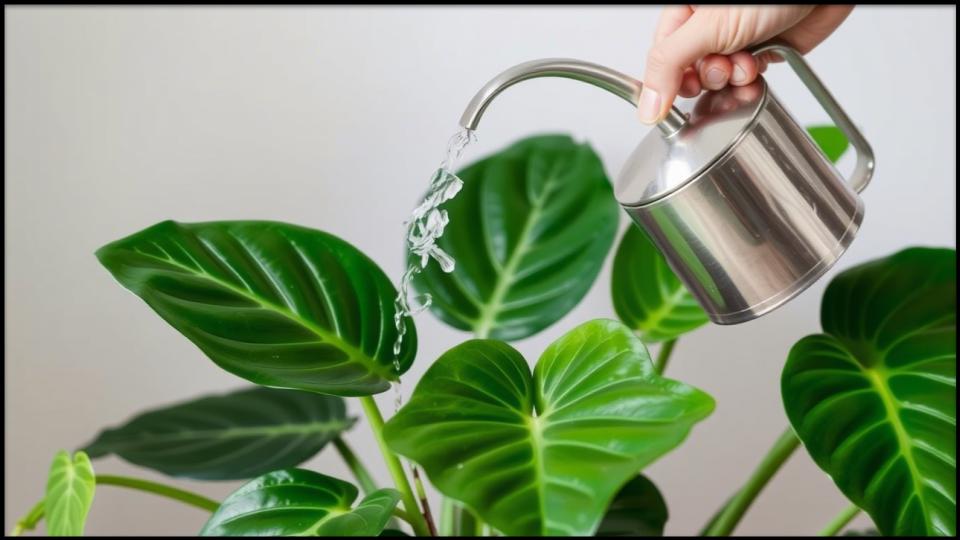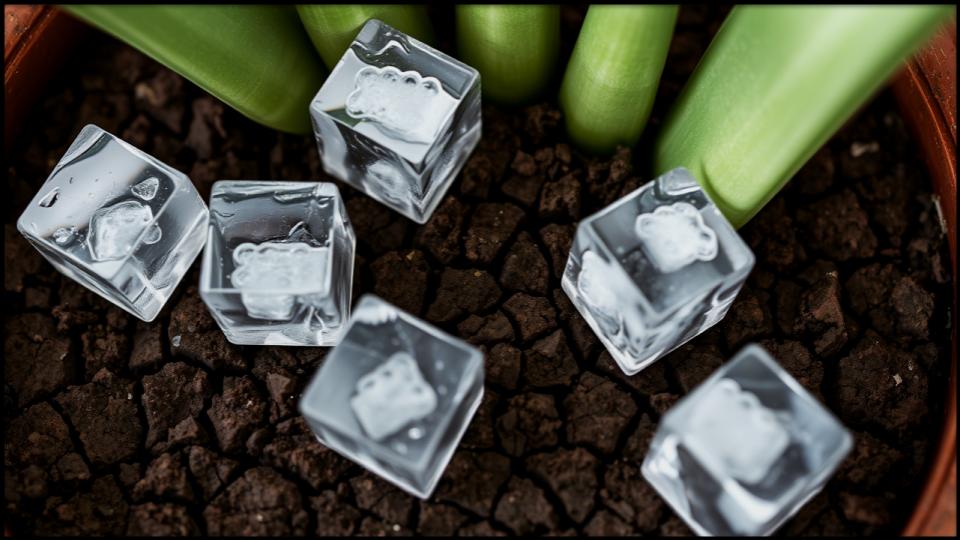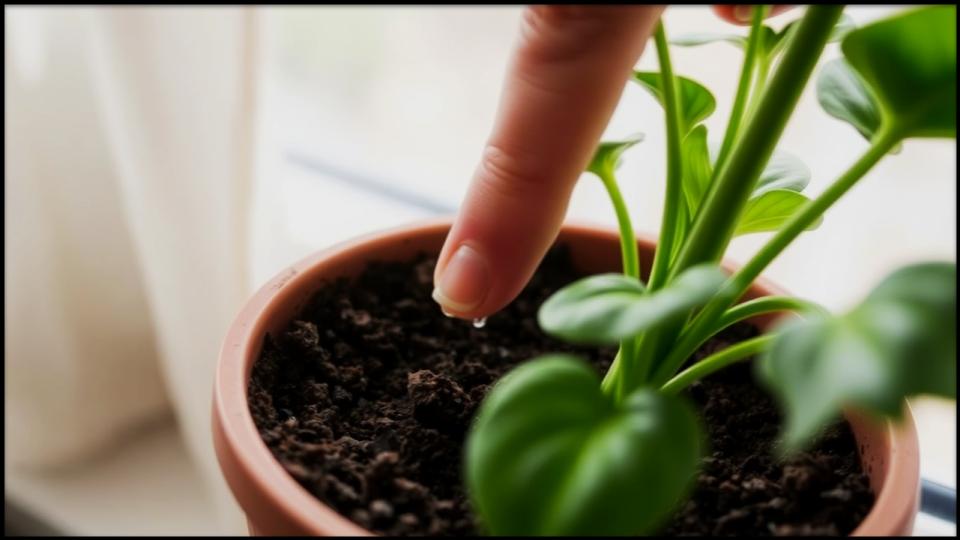
It’s a tip that has circulated through social media feeds and online forums for years, presented as a clever, time-saving “hack” for the modern plant parent: simply place a few ice cubes on the soil of your houseplant and let them melt. The logic seems plausible enough—a slow, steady release of water that prevents the dreaded mistake of overwatering. But as a horticulturist who has dedicated years to understanding what makes plants truly thrive, I can tell you this popular shortcut is one of the most pervasive Watering Houseplants with Ice Cubes I encounter.
This article will gently debunk the ice cube myth and illuminate the potential harm it can cause. More importantly, it will empower you with the knowledge and confidence to provide water in the way your houseplants have evolved to receive it. We’ll explore the science behind proper watering and give you simple, actionable techniques to ensure your indoor garden remains a source of beauty and joy, not stress. Let’s move beyond the quick fixes and cultivate a deeper understanding of our leafy companions.
What You Need to Know
- Avoid the Ice: Watering houseplants with ice cubes can shock their roots with cold temperatures, leading to stress and damage, especially for tropical species.
- Promote Deep Roots: Ice cubes only wet the top layer of soil, which encourages shallow, weak root systems and leaves the base of the plant thirsty.
- Check First, Then Water: The most reliable way to know if your plant needs water is to feel the soil. Insert your finger one to two inches deep; if it’s dry, it’s time to water.
- Water Thoroughly: When you do water, do so generously. Drench the soil with room-temperature water until it flows freely from the pot’s drainage holes. This ensures the entire root ball is hydrated.
The Cold, Hard Facts: Why Watering Houseplants with Ice Cubes Is Harmful
The appeal of using ice is understandable. It feels measured, controlled, and safe. However, this method overlooks the fundamental biology of most of our favorite houseplants, which are overwhelmingly tropical in origin. They are accustomed to warm, humid environments and gentle, drenching rains—the exact opposite of a sudden, icy chill.

The Shock Factor: The Dangers of Cold Water on Plant Roots
Imagine being woken from a warm, comfortable sleep by a bucket of ice water. That’s a dramatic but fair analogy for what a plant’s sensitive root system experiences. According to horticulturists at the Missouri Botanical Garden, using ice-cold water is harmful to the roots of tropical plants and can cause significant damage.
This sudden, intense cold can send the roots into a state of shock. This physiological response can constrict the plant’s vascular system, temporarily hindering its ability to absorb water and nutrients. For a plant that has adapted over millennia to thrive in temperatures consistently above 65°F (18°C), this icy assault is a profound stressor that can lead to leaf drop, stunted growth, and an overall decline in health. In all my years of consulting, when a client shows me a struggling plant with yellowing leaves despite their “careful” watering, this ice cube method is often the hidden culprit.
Shallow Hydration and Thirsty Roots
Beyond the temperature shock, watering houseplants with ice cubes promotes an unhealthy watering pattern. As the ice melts, the water penetrates only the top inch or two of the soil. This has two negative consequences:
- It encourages shallow root growth. When water is consistently available only at the surface, roots have no incentive to grow downward. This results in a weak, underdeveloped root system that is less resilient and less capable of anchoring the plant.
- It fails to hydrate the entire root ball. The deep, essential roots at the bottom of the pot are left completely dry. As certified professional horticulturist Leslie F. Halleck notes in a Southern Living article, a few ice cubes may not provide nearly enough water for a medium or large plant, leaving the lower roots consistently thirsty. This leads to a plant that is simultaneously overwatered at the surface and dehydrated at its core.
The Great Orchid Debate: An Exception to the Rule?
If there is one plant most associated with the ice cube method, it is the Phalaenopsis, or moth orchid. In fact, some commercial growers have marketed orchids specifically with the “just add ice” instruction, which has only fueled the confusion. The idea is that it prevents water from logging in the chunky bark medium, which is a real risk for orchids.
While a study co-authored by researchers at The Ohio State University and The University of Georgia found that ice cube irrigation did not cause immediate damage to orchids in a short-term trial, it also found no significant benefit over using an equivalent amount of room-temperature water. Critically, experts at institutions like the Phipps Conservatory and Botanical Gardens strongly advise against the practice, emphasizing that these are tropical plants whose sensitive aerial roots can be damaged by the cold.
My professional advice? Skip the gimmick. The risk of cold damage and insufficient watering outweighs any perceived convenience. There is a much better way to water orchids and all your other houseplants.
The Art of the Perfect Drink: Proper Watering Techniques for Houseplants
Learning to water correctly is the single most important skill a plant owner can develop. It’s less about a rigid schedule and more about observation and response. By mastering these proper watering techniques for houseplants, you’ll build a stronger connection with your plants and be rewarded with lush, vibrant growth.

Step 1: Always Check the Soil First
Before you even reach for the watering can, check if your plant is actually thirsty. A rigid schedule—like watering every Saturday—is one of the biggest Watering Houseplants with Ice Cubes mistakes. A plant’s water needs change with the seasons, light levels, and humidity.
The best tool for the job is your finger.
- For most tropical houseplants: Insert your index finger into the soil up to your second knuckle (about 2 inches). If the soil feels dry at your fingertip, it’s time to water. If you feel moisture, wait another day or two and check again.
- For cacti and succulents: Allow the soil to dry out completely between waterings.
Step 2: Use Room-Temperature Water
Never use icy water or hot water from the tap. The ideal temperature is tepid or lukewarm—essentially, room temperature. As the University of Illinois Extension suggests, using room-temperature water avoids shocking the plant’s system. I like to fill my watering can and let it sit out for several hours (or overnight) to allow the water to reach ambient temperature and for some chemicals, like chlorine, to dissipate.
Step 3: Water Thoroughly and Deeply
When it’s time to water, be generous. The goal is to completely saturate the root ball.
- Place the plant in a sink or bathtub, or on a large saucer.
- Slowly pour water over the entire surface of the soil until it begins to flow freely from the drainage holes in the bottom of the pot. This deep drenching flushes out accumulated mineral salts from fertilizers and ensures every root gets access to moisture.
- Let the pot drain completely for 15-30 minutes. It is crucial that the plant does not sit in a saucer full of water, as this can lead to root rot.
This “drench and drain” method is the gold standard I recommend to every plant owner. It mimics a natural, heavy rainfall and encourages a deep, robust root system.
A Better Way to Grow
Embracing the role of a plant parent means learning to listen to and observe what our plants need. While the idea of watering houseplants with ice cubes promises simplicity, it ultimately creates more problems than it solves, standing between you and a thriving indoor garden.
By retiring the ice cube “hack” and adopting the practice of checking the soil and watering deeply with room-temperature water, you are not just following instructions—you are engaging in a timeless horticultural tradition. You are providing care that aligns with the very nature of the plants you invite into your home. This mindful approach is not only more effective, but infinitely more rewarding.
Read More
One Simple Fix Could Bring Your Jade Plant Back from the Brink—Here’s How
